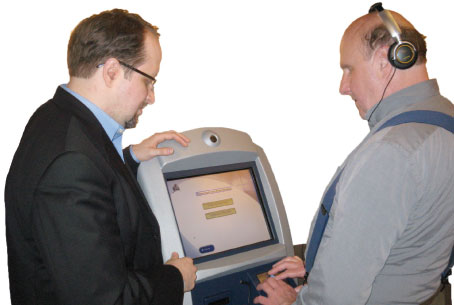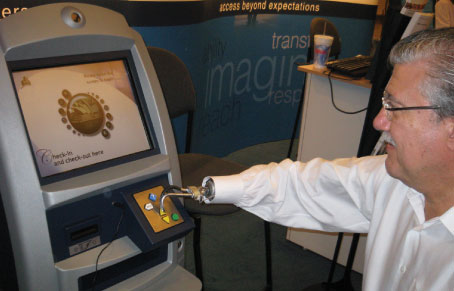The Challenge
Travelling for business or pleasure isn’t what it used to be. In order to develop and maintain brand loyalty while streamlining operations in an increasingly competitive global market, travel and transportation companies are challenged to transform their business processes and integrate new forms of customer-facing technology. Self-service kiosks have played an important role in this transformation.
However, while self-service kiosks have the potential to improve the traveller experience by making travelling easier, quicker and more enjoyable, some travellers who have physical disabilities may experience barriers when trying to use them:
- Touchscreens can be difficult if not impossible to use by travellers who have limited or no vision or dexterity
- Buttons, card readers, passport readers and other hardware controls may not be discernable by touch
- An alternative access method, such as audio, may not be available to travellers who have limited or no vision.

The Industry Opportunity
Accessible kiosks and self-contained, closed systems have already been employed successfully in other industries such as retail banking and government. Travel and transportation companies are increasingly interested in removing barriers to self-service kiosk accessibility so they can:
- Continuously improve the traveller experience and differentiate themselves
- Build brand loyalty in an increasingly competitive global market
- Capture market share for the growing segment of travellers with disabilities
- Comply with a variety of central or regional government accessibility regulations (e.g. Americans with Disabilities Act, Canadian Government Travel Policies, Australian Standards for Accessible Public Transport, UK Disability Discrimination Act, California Civil Code 54.9, etc).
The Market Demand
Active seniors and technologically empowered people with disabilities represent significantly expanding market segments in travel and transportation; their sheer numbers and collective levels of disposable income make them hard to ignore.
For example, some 420 million people across the planet are 65 or older, and their numbers are expected to increase dramatically over the next two decades. In particular, baby boomers entering retirement represent a huge opportunity, since older populations travel more than any other age group, registering some 260 million trips a year. According to one recent industry report, active seniors are one of four major customer segments forecast to have a substantial effect on the airline industry during the next 15 years.
In addition, the worldwide population of nearly 500 million people with disabilities is notable not just for their use of technology in personal and professional settings, but for their sizable spending levels. According to one study, travellers with disabilities spend in excess of $13 billion annually on business and leisure travel. Another study by the National Telecommunications and Information Administration reports that nearly three out of four people with some form of disability use the internet at home and at work. Such a high technology adoption rate indicates that people with disabilities are becoming more adept at using the assistive technologies (e.g. speech input/output, specialised keyboards, etc.) that help them access the internet and computer technology in general.
Meeting the Demand
So how should travel and transportation companies address accessibility in a way that helps them meet the needs of these market segments while making a positive impact on their bottom line?
Firstly, travel and transportation businesses should stay up to date about accessibility laws, regulations, and guidelines in the regions where they operate. Many jurisdictions may require provision of additional or alternative functionality that makes their facilities or services, including self-service kiosks, more accessible to persons with disabilities.
Secondly, travel and transportation businesses should adopt self-service kiosk accessibility best practices to capitalise on market opportunity. While global accessibility standards for travel and transportation industry self-service kiosks have yet to be defined, references such as the IBM Hardware Self-Contained, Closed Product Accessibility Checklist offer useful best practices that can help travel and transportation companies stay ahead of the curve.

Example Solutions
While accessible self-service kiosks are somewhat new in the travel and transportation industry, there are important precedents and examples of successful implementations in multiple industries.
For example, accessibility features are now often standard in automated banking machines (ABMs). Most ABMs now offer audio guidance when the customer plugs a headphone into a headset jack. By following the audio cues and finding the correct buttons via Braille labels on the machine, a customer can conduct transactions as easily as someone without a disability.
The U.S. Postal Service’s Automated Postal Center incorporates the Trace Center’s EZAccess techniques for accessibility. These features, including audio prompts and a special keypad, make it easier for customers who have limited or no vision, physical limitations, and cognitive impairments, to use the system without assistance.
The award-winning Automated Postal Center has helped the U.S. Postal Service generate revenue, improve operational efficiency, and support its key strategy to “Enhance Access and Ease of Use.”
In the travel industry, solutions are now available and being deployed in the market. For example, many subway/train fare card and ticketing kiosks provide audio-based guidance on buying fare cards or tickets.
The Accessible IBM T&T Self-Service Kiosk is an industry-leading solution that integrates several accessibility features into IBM’s market-leading self-service hardware and software applications:
- A headset jack with volume control
- Tactilely discernable hardware controls
- Speech output and layered audio help
- On-screen highlighting
- Specialised keypad or keyboard options that are operable by those with limited dexterity.
This innovative solution debuted in the Guestroom 2010 Exhibit at HITEC 2007, and was also demonstrated at Check-In ’07. In March 2008, it was demonstrated at the 23rd Annual International Conference on Technology and Persons with Disabilities at California State University-Northridge, where many attendees commented on how useful the solution would be in helping them independently check-in at hotels and airports.
While currently there are no travel industry standards for accessible kiosk design, market demand is increasing for self-service kiosks that can easily be used by seniors and people with disabilities. Travel and transportation companies should seriously consider how implementation of accessible self-service kiosks might help them meet or exceed key business goals related to competitive differentiation, brand loyalty and market share.






